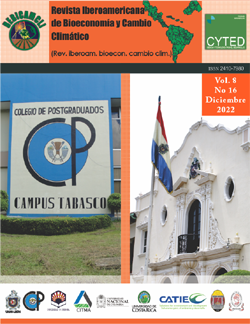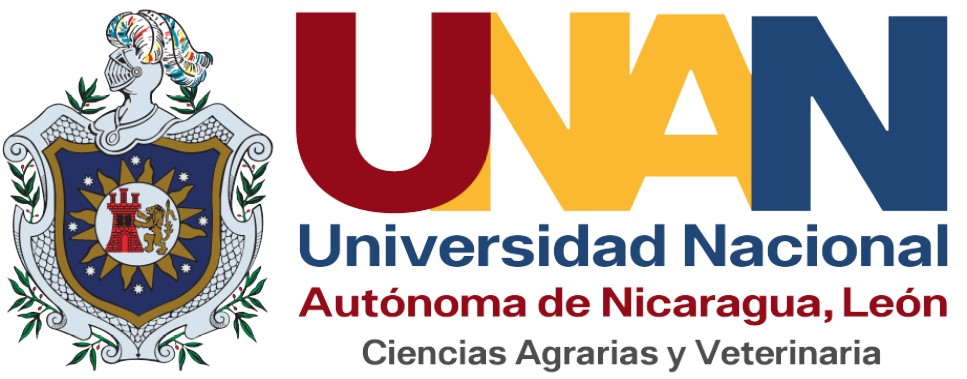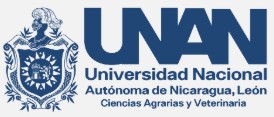Vulnerability, climate change and sea level rise in Boca del Río, Veracruz
DOI:
https://doi.org/10.5377/ribcc.v8i16.15042Keywords:
Socioeconomic vulnerability, Economic impact, Coast geo, Coastal GeographyAbstract
The socioeconomic vulnerability of cities located in front of the Gulf of Mexico is an issue that requires first-order attention given the effects of climate change that is impacting them, both on economic activities and human settlements, as well as on coastal ecosystems (estuaries and mangroves) located on the coastline. Hence the importance of the research since the random behavior of climate change, linked to the increase in disasters, transcends in a certain way in the sustainable development of the coastal towns of the Gulf of Mexico. Therefore, this research has set itself the objective of exposing the social, economic and cultural impacts that the municipality of Coatzacoalcos, Veracruz, may suffer under any scenario where the sea level suddenly increases by 5 meters. The methodological guide was of an interdisciplinary nature, which consisted on the one hand in locating and classifying the territorial distribution of the vulnerable groups that are currently within the danger zone and on the other, in qualifying through field trips, the singularities of the themselves. Some of the most significant results are: if the municipality of Coatzacoalcos suffered a flood of five meters above sea level, 15% of its territory would be flooded, that is, 48 km2 of its municipal territory would present a certain degree of socioeconomic vulnerability to the increase of sea level. Based on this, it is proposed to exponentially promote the disaster prevention policy aimed at the most vulnerable people.
Downloads
Metrics
References
Armenta, S., López, J., Rodríguez, E., Ellis, E., del-Amo, S., Gómez, A., ... y Velázquez-Rosas, N. (2012). "La restauración ecológica como estrategia para la reducción del riesgo de desastre ante inundaciones: estudio de caso de la Cuenca del Río Coatzacoalcos". En: Tejeda, A. y Betancourt, L. (coord.) (2012). Las inundaciones de 2010 en Veracruz. Memoria social y medio físico. México: Consejo Veracruzano de Investigación Científica y Desarrollo Tecnológico. 216-258 pp.
Casado, J., y Sánchez, M. (2013). Coatzacoalcos: Reestructuración urbana e inversión privada en una ciudad media mexicana. EURE, 39(117), 91-116. https://doi.org/10.4067/S0250-71612013000200005
Castilla, J. (2003). Influencia del sistema de ríos en el desarrollo económico y poblacional de la ciudad de Coatzacoalcos, Veracruz. México: Tesis de licenciatura, Universidad Nacional Autónoma de México.
DOF (Diario Oficial de la Federación) (2020). Actualización de la disponibilidad media anual de agua en el acuífero Costera de Coatzacoalcos (3012), Estado de Veracruz, 15 de abril, Ciudad de México, Segob, < https://sigagis.conagua.gob.mx/gas1/Edos_Acuiferos_18/veracruz/DR_3012.pdf>, 31 de marzo de 2020.
Cruz, C. (2016). Evaluación de la Vulnerabilidad en las costas mexicanas, Tesis de maestría, Universidad Nacional Autónoma de México, Ciudad de México.
Cutter, Susan, Boruff Bryan y Shirley Lynn, (2003). Social vulnerability to environmental hazards, Social Science Quarterly, 84 (2), 242-261, https://doi.org/10.1111/1540-6237.8402002
González-Estrada, A., & Gallegos-Cedillo, G. (2014). El producto interno bruto de los municipios de México: II. Estados MZ. Revista mexicana de ciencias agrícolas, 5(8), 1405-1421.
González, C. (2019). Cambios en la estructura espacial del comercio minorista en Coatzacoalcos, Veracruz. México: Tesis de maestría, Universidad Nacional Autónoma de México.
Grinsted, A., Moore, J. C., & Jevrejeva, S. (2010). Reconstructing sea level from paleo and projected temperatures 200 to 2100 AD. Climate dynamics, 34(4), 461-472. https://doi.org/10.1007/s00382-008-0507-2
INEGI (Instituto Nacional de Estadística, Geografía e Informática), (2012). "Sistema de Cuentas Nacionales de México, Producto Interno Bruto por entidad federativa 2006-2010, Año base 2003, Segunda versión", Aguascalientes, INEGI, , 6 de mayo de 2019.
INEGI (Instituto Nacional de Estadística, Geografía e Informática), (2020). "Resultados definitivos, Censo de población y vivienda 2020", Aguascalientes, INEGI, , 13 de marzo de 2021.
INEGI (Instituto Nacional de Estadística, Geografía e Informática), (2012). "Sistema de Cuentas Nacionales de México, Producto Interno Bruto por entidad federativa 2006-2010, Año base 2003, Segunda versión", Aguascalientes, INEGI, , 6 de mayo de 2019.
INEGI (Instituto Nacional de Estadística, Geografía e Informática), (2011). "Cartografía geoestadística urbana, Cierre del Censo de Población y Vivienda 2010. Coatzacoalcos", Aguascalientes, INEGI, < https://www.inegi.org.mx/contenidos/productos/prod_serv/contenidos/espanol/bvinegi/productos/geografia/urbana/SHP/Veracruz_de_Ignacio_de_la_Llave/SHP/702825678319_s.zip>, 30 de septiembre de 2020.
INEGI (Instituto Nacional de Estadística, Geografía e Informática), (2010). "Compendio de información geográfica municipal de los Estados Unidos Mexicanos Coatzacoalcos, Veracruz de Ignacio de la Llave clave geoestadística 30039", Aguascalientes, INEGI, < https://www.inegi.org.mx/contenidos/app/mexicocifras/datos_geograficos/30/30039.pdf>, 19 de mayo de 2021.
Martínez, Manuel José, (2007). "Los 10 desastres más costosos en México", Expansión, 08 de noviembre de 2007, , última fecha de consulta: 21 de diciembre de 2018.
INFONAVIT (Instituto del Fondo Nacional de la Vivienda para los Trabajadores), (2014). Demanda Potencial, (4° bimestre del 2014), Ciudad de México, Instituto del Fondo Nacional de la Vivienda para los Trabajadores.
IPCC (Intergovernmental Panel on Climate Change), (2007). Climate Change 2007: Impacts, Adaptation and Vulnerability. Contribution of Working Group II to the Fourth Assessment Report of the Intergovernmental Panel on Climate Change, Cambridge, Cambridge University Press.
Kopp, R. E., Kemp, A. C., Bittermann, K., Horton, B. P., Donnelly, J. P., Gehrels, W. R., ... & Rahmstorf, S. (2016). Temperature-driven global sea-level variability in the Common Era. Proceedings of the National Academy of Sciences, 113(11), E1434-E1441. https://doi.org/10.1073/pnas.1517056113 PMid:26903659 PMCid:PMC4801270
LARED (Red de Estudios Sociales en Prevención de Desastres en América Latina), (2019). DesInventar, Sistema de Inventario de Desastres, Versión, 10.02.009, Cali LARED, corporación OSSO y UNDRR.
Lira, L. y Quiroga, B. (2009). Técnicas de análisis regional, Santiago de Chile. Comisión Económica para América Latina y el Caribe, División de Desarrollo Sostenible y Asentamientos Humanos.
León, J., Vargas, P., García, A., Herbas, M., Fernández, F., Montiel, A. y Zavaleta, B. (2019). Seguimiento de hijos de madres con infección por virus ZIKA en una Unidad de Primer Nivel de Atención Médica de Coatzacoalcos Veracruz, México del Instituto Mexicano del Seguro Social. Prensa méd. argent, 105(5): 259-269.
Méndez, I. R., Tejeda, A., y Ramírez, I. S. (2010). Relación estadística entre la temperatura ambiente y las enfermedades diarreicas en Coatzacoalcos, Veracruz (México). Investigaciones geográficas, (73), 119-128.
Ramírez-Núñez, C., y Parrot, J. F. (2014). Flood simulation in the coastal plain of Coatzacoalcos (Veracruz, Mexico) using LiDAR. In 2014 IEEE Geoscience and Remote Sensing Symposium (pp. 1975-1978). IEEE. https://doi.org/10.1109/IGARSS.2014.6946848
Ruiz, N. (2017). Asociaciones público-privadas en la reducción de riesgo de desastres. El caso de la industria química de Coatzacoalcos, México. Gestión y política pública, 26(1), 105-138.
SEDESOL. (2003). Guía metodológica para la elaboración de atlas de peligros naturales a nivel ciudad. México: Secretaría de Desarrollo Social.
SEDESOL. (2011). Atlas de Riesgos Naturales del Municipio de Coatzacoalcos. México: Secretaría de Desarrollo Social. http://rmgir.proyectomesoamerica.org/PDFMunicipales/2011/vr_30039_AR_COATZACOALCOS.pdf
SEFIPLAN. (Secretaria de Finanzas y Planeación del Estado de Veracruz) (2016). Sistema de información municipal. Cuadernillos municipales, 2016. Coatzacoalcos. México: Gobierno de Veracruz. http://ceieg.veracruz.gob.mx/wp-content/uploads/sites/21/2016/05/Coatzacoalcos.pdf
Singh, S., Pacheco, J., Pérez, X., Ordaz, M., y Reinoso, E. (2015). The 6 september 1997 (Mw4.5) coatzacoalcos-minatitlan, veracruz, mexico earthquake: Implications for tectonics and seismic hazard of the region. Geofisica Internacional, 54(2), 191-199. https://doi.org/10.1016/j.gi.2015.04.014
Tovar Cabañas, R., & Vázquez Espinosa, S. A. (2017). Análisis geoestadístico de las muertes por neoplasia en la población de 55 y más años en los municipios del Estado de Veracruz. Universalud, 13(25), 49-58.
USDA. (United States Department of Agriculture) (2017). "Cost estimating guide for road construction", Washington DC, United States Department of Agriculture, https://www.fs.usda.gov/Internet/FSE_DOCUMENTS/stelprdb5279284.pdf última fecha de consulta: 8 de marzo de 2019.
Veyret, Y., & Laganier, R. (2013). Atlas des risques en France. Prévenir les catastrophes naturelles et technologiques. Paris: Autrement.
Webster, J. M., Clague, D. A., Riker-Coleman, K., Gallup, C., Braga, J. C., Potts, D., ... & Paull, C. K. (2004), Drowning of the -150 m reef off Hawaii, A casualty of global meltwater pulse 1A?. Geology, 32 (3), 249-252,.1 https://doi.org/10.1130/G20170.1
Zavala-Hidalgo, J.; De Buen-Kalman, R.; Romero-Centeno, R. y Hernández-Maguey, F. (2011). "Tendencias del nivel del mar en las costas mexicanas", en Alfonso, Botello; Susana, Villanueva; Jorge, Gutiérrez y José Luis, Rojas Galaviz (eds.), Vulnerabilidad de las zonas costeras mexicanas ante el cambio climático, Campeche, Gobierno del Estado de Tabasco, Semarnat-INE, UNAM-ICMyL, Universidad Autónoma de Campeche, pp. 315-333.
Downloads
Published
How to Cite
License
Copyright (c) 2022 Rev. iberoam. bioecon. cambio clim.

This work is licensed under a Creative Commons Attribution-NonCommercial-ShareAlike 4.0 International License.
Copyright © 2025 Rev. iberoam. bioecon. climate change. National Autonomous University of Nicaragua León (UNAN-León), Knowledge Area of Agrarian and Veterinary Sciences / Specific Area of Agroecology and Agribusiness / Center for Research in Agrarian Sciencies. Academic Directorate. Research Department. Publication and scientific events Unit.












 EDITORIAL
EDITORIAL e-ISSN
e-ISSN


 COPYRIGHT
COPYRIGHT This work is licensed under a Licencia Internacional
This work is licensed under a Licencia Internacional 












